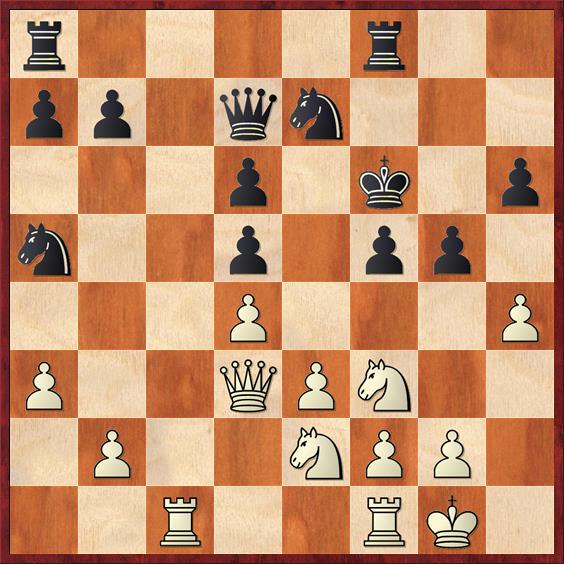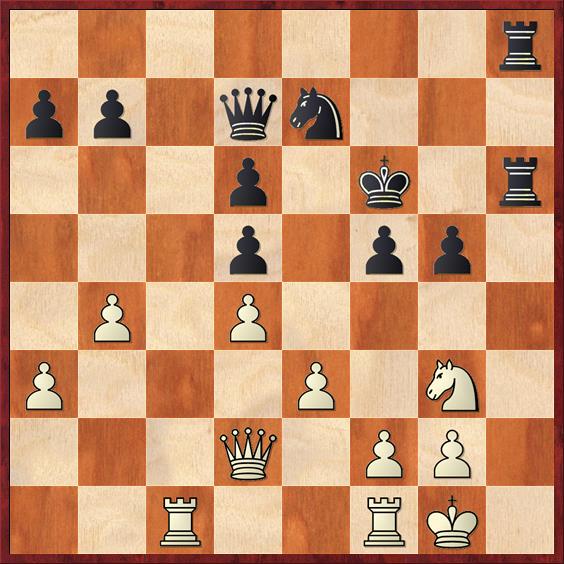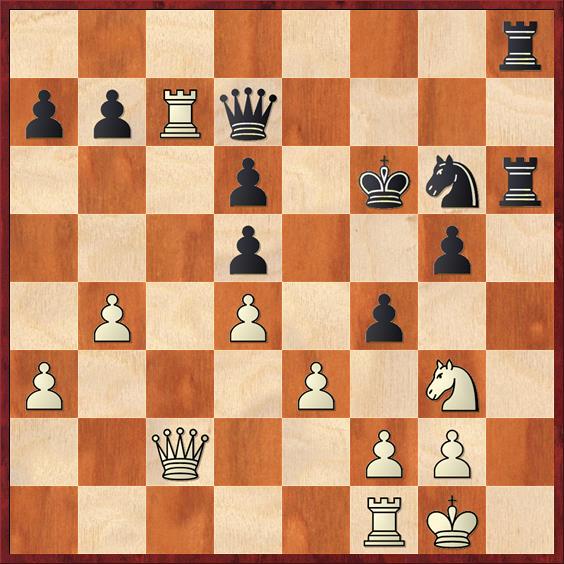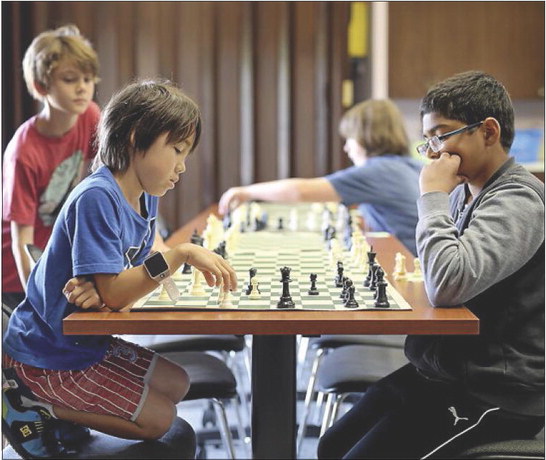I really will write about what the title says, but first I want to show the photo of this weekend’s chess tournament that appeared in the Santa Cruz Sentinel. Ryu Cirillo is at left, Shaashuat Shetty on the right, and slightly blurry on the left is Atlee Haldeman. (Atlee wasn’t mentioned in the paper, but I want to mention him because he is probably the most faithful attendee at the Aptos Library Chess Club. I think he has attended regularly for three or four years.)
Yesterday I played a training game against Shredder, the computer program, that really highlighted the one significant weakness that I have discovered in it. I’ve noticed before that a significant fraction of my most crushing wins against it involve attacks on an open h-file. The program just doesn’t seem sufficiently aware that an open h-file, if it is controlled by your opponent, is a kiss of death when you are castled kingside.
All chess programs, I believe, slightly underestimate the danger of a kingside pawn storm. A decade ago, when I used to play against Fritz 7, I was always happy when it played the King’s Gambit Declined as Black, because it usually meant that I would get to play f5, g4, g5 etc. and just blow the kingside open. I think that computers find it difficult to properly evaluate such attacks because they take quite a few moves to develop. But those moves are extremely easy ones for a human player to find: just push, push, push the pawns.
But Shredder is even weaker than most programs at defending against kingside pawn storms, because it seems to feel that exchanging h-pawns will help. Here’s my game from yesterday that proves the point. Note: Its rating was set at 2201 for this game, so it isn’t full-strength Shredder that we’re talking about. Full-strength Shredder would probably have played a little better.
 Position after 17. … Kf6. White to move.
Position after 17. … Kf6. White to move.
FEN: r4r2/pp1qn3/3p1k1p/n2p1pp1/3P3P/P2QPN2/1P2NPP1/2R2RK1 w – – 0 18
I’m playing Black here. It isn’t a wonderful position for me, because I have made too many positional concessions in order to get my kingside pawn storm going. It’s not really clear how I am going to break through on the kingside, because if lines open up my king is going to become a target, too. Here Rybka, after 5 minutes and 13 ply of analysis, prefers the move 18. Nc3 for White, with an evaluation of +0.93. I agree that this is kind of a cute move. It’s a “baiting” move: if Black plays 18. … Nb3 or 18. … Nc4 White wins a pawn with 19. Nxd5+. If Black plays 18. … g4 then the knight can come right back to e2 and f4 with a permanent outpost.
But Shredder made my life easier with a misguided trade of h-pawns: 18. hg? hg. Of course White’s position is still okay, but he has to be careful. For me, the trade is a godsend because it gives me an easy plan of attack that doesn’t involve any risk: double or even triple my heavy pieces on the h-file and see what happens.
The game continued 19. b3 Rh8 20. Ng3? This also looks like a mistake to me. The one thing that White’s king needs most of all is air, but by putting his knight on g3 Shredder makes it impossible to create luft. The knights protect h2 and h1, of course, but they are easily dislodged. Here Rybka gives 20. Nd2 as its top choice, with an evaluation of +0.65, which makes sense to me because White can now contemplate f3 and e4.
Now we get a little comedy of errors: 20. … Rh6 21. b4? Nc4 22. Nd2 (finally!) Nxd2?
Argh! What was I thinking? If I play the simple 22. … b5 my outpost on c4 is secure and I do not have to worry about any White counterplay on the queenside. Did I mention that this was rapid chess (10 minutes for 40 moves)?
The game continued 23. Qxd2 Rah8 and it’s time for another diagram.
 Position after 23. … Rah8. White to move.
Position after 23. … Rah8. White to move.
FEN: 7r/pp1qn3/3p1k1r/3p1pp1/1P1P4/P3P1N1/3Q1PP1/2R2RK1 w – – 0 24
Black has carried out his simple plan of doubling on the h-file. Still, after a simple defensive move like 23. f3 or 23. f4 (Rybka’s choice) I don’t see White getting checkmated. I think this is what any human would do.
But Shredder continues to be blind to the power of the h-file, and naively thinks that its control of the c-file is just as important. It plays 24. Rc3? Ng6 25. Qc2? (last chance for 25. f4!) 25. … f4! 26. Rc7. (Diagram)
 Position after 26. Rc7. Black to move.
Position after 26. Rc7. Black to move.
FEN: 7r/ppRq4/3p1knr/3p2p1/1P1P1p2/P3P1N1/2Q2PP1/5RK1 b – – 0 26
Here’s where you get your tactical reward for reading this far. How does Black finish White off?
At first I was excited because I thought I could sacrifice my queen with 26. … fg? 27. Rxd7?? Rh1 mate. But then I realized that 26. … fg 27. fg+! is check, and White can then take my queen safely.
Fortunately there is a more effective move: 26. … Qg4! This has several neat points. First, White cannot trade queens with 27. Qe2 because of 27. … Rh1+! deflecting the knight. (Comment added after posting: Oops! Even more effective is 27. … Qxe2 and the knight can’t recapture because of mate on h1. Deflection the other direction!) Likewise, 27. Qd1 fails to 27. … Qxd1 28. Rxd1 fg. Now the recapture comes without check, and Black wins more material: 29. fg Rh1+ etc. Of course, it’s far too late to create luft with 27. f3 because 27. … Qxg3 completes the mating net.
So White has nothing better than the move Shredder played, 27. Rxb7. But then I played the nice winning move: 27. … f3! The threat is … Rh1+ followed by … Qxg2 mate. On the “only conceivable defense,” 28. gf, Black has another neat checkmate with 28. … Rh1+ 29. Kg2 R2h2 mate.
I put “only conceivable defense” in quotes, because Shredder in fact found another defense — giving up its queen for no compensation with 28. Qf5+ Qxf5. Note that it can’t recapture with 29. Nxf5 because of 29. … Rh1 mate, so it’s just down a queen. It soldiered on one more move with 29. Rb8 Qg4 and then White resigned.
In a way the winning combination with 26. … Qg4 seems a little bit lucky, because I actually didn’t foresee all of those tactical tricks. But that’s the thing about kingside pawn storms and especially attacks that involve open h-files: once you get to the point of hand-to-hand combat, the tactical tricks are almost always there. It isn’t strictly necessary to see them in advance.
Realizing that Shredder has this weakness, I have to once again question whether I’m learning anything of value by training against the computer. While it’s fun to win, and it’s fun to figure out the tactics in the third diagram, human opponents are not going to just let me open the h-file and not do anything about it, as Shredder did. And playing such games might get me into the habit of overrating kingside pawn storms. Indeed, prior to the first position I probably had overrated my attacking chances, but Shredder let me get away with it.
Conclusion: I really need to play against more humans. But there’s no chess club for adults in Santa Cruz. Sad but true!




{ 6 comments… read them below or add one }
You should come over to Kolty. 🙂
It’s Thursday, so the play is on tonight, and I am giving a lecture, too.
As for the h-file stuff, here’s an outstanding article by Tim Krabbe:
http://timkr.home.xs4all.nl/chess2/honor.htm
Pretty cool! Of course the programs in Krabbe’s article were Fritz 6 and that era; I feel as if Rybka was a considerable improvement over them. But if you’re playing a program that is weakened on purpose (like me playing against Shredder set to 2201), they still fall into the same h-file follies.
Recently I’ve come across two cases of computer incompetence:
1. In the game Volkitin – Mamedyarov, Eilat 2012 in the final position it takes Stockfish about 12 hours to make any progress.
2. In the game Polugaevsky – Geller, Skopje 1968 in the position after Black’s 42nd move Stockfish couldn’t make any progress when left to contemplate for something like 3 days. It only caught up with Polugaevsky’s brilliancy at move 50 or something.
Three questions
Does 26 … Qg4 really deserve an exclamation mark? Isn’t it a forced move to avoid immediate loss?
Instead of the tempo wasting 27. Rb7 which loses without a fight, can White try 27. e4 instead? Black’s king may be in some danger too. I haven’t taken any time to look at this so maybe it does nothing. You didn’t mention it in your notes, so I was wondering if you had considered it.
And something for you to contemplate. Does playing rapid chess, 1o minutes for 40 moves, help you to work on your weakness of not looking at enough candidate moves, or does it reinforce bad habits?
Regards,
Mike
Hi,
How often do you play against the chess engines? Are you just playing for fun, or is it part of your regular training? Thanks.
Best regards,
Bryan
Hi Bryan, Mostly I’m playing for fun but I’m also trying to have a serious training side to it. Maybe 75 percent the first and 25 percent the second. One of the “serious” things I do is to take one time-out per game at what I think is a critical moment, and try to analyze the critical position deeply. I’ve called this “Matrix chess” and written several blog posts about it. In general I’ve found that to be useful in some ways, although possibly dangerous because I will never have the luxury of infinite time in a tournament game.